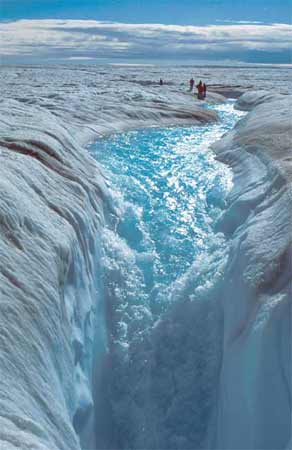Records Melt Away on Greenland Ice Sheet


The disappearing Greenland Ice Sheet set several records during an unusually long melt last year, according to a new study.
Running from April to mid-September, the melt season of 2010 was about a month longer than usual, said study team member Jason Box, a geographer and climatologist at Ohio State University.
The extra-long melt was caused by reduced snowfall and summer temperatures up to 5.4 degrees Fahrenheit (3 degrees Celsius) above the average, according to the study, which is detailed today (Jan. 21) in the journal Environmental Research Letters.
Low snowfall meant that 2010 was also a record year in the red for the ice sheet's snowfall budget. This budget can be thought of like a bank account: Each year's new snowfall is a deposit into the account; each year's melting is a withdrawal. A healthy glacier would have a balanced budget where the fresh snowfall is equal to the amount of snow that melts. The year 2010 was not a healthy year for the Greenland Ice Sheet and "the budget was substantially in deficit," Box told OurAmazingPlanet.
Since more snow melted than piled up, the ice sheet's bare ice was exposed earlier than average and longer than previous years, which triggered more melting.
"Bare ice is much darker than snow and absorbs more solar radiation," said team member Marco Tedesco, director of the Cryosphere Processes Laboratory at the City College of New York. "This means the old ice is warming, melting and running off into the sea."
Meltwater runoff, also at a record high in 2010, saturated what snow was on the ice sheet, also fueling melting.
Get the world’s most fascinating discoveries delivered straight to your inbox.
The record melt year is expected to be a major contributor to the projected sea level rise, which is expected to top 3.3 feet (1 meter) by 2100.
- Images: Glaciers Before and After
- Meltwater Could Paradoxically Slow Glacier Flow
- In Images: Trekking to a Treacherous Glacier
Reach OurAmazingPlanet staff writer Brett Israel at bisrael@techmedianetwork.com. Follow him on Twitter @btisrael.


